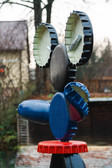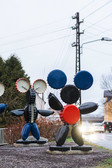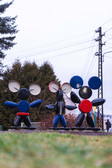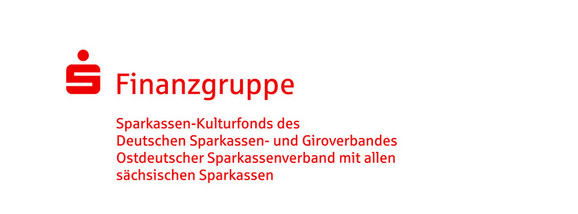Jan Kummer: Heimat Ensemble II
Gersdorf

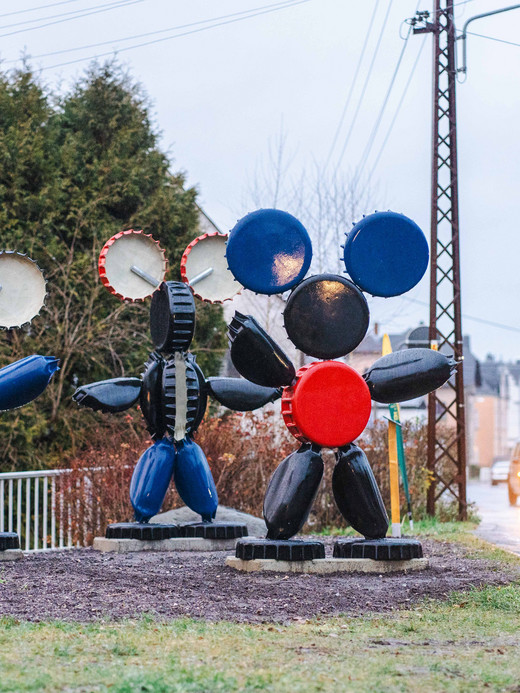
The Heimat Ensemble II group by painter, object and conceptual artist Jan Kummer consists of round elements of the same size, reminiscent of enlarged crown caps. The models for Kummer's sculptures seem to originate from the aimless tinkering in the private sphere of a GDR household, in which anonymous everyday materials were transformed into individual objects. The vertically or horizontally assembled or centrally folded elements with inwardly curved edges and 21 spikes in black, red, blue and green are reminiscent of Mickey Mouse, probably the world's most famous art figure. In the 1930s, the later world-famous American cartoonist and media entrepreneur Walt Disney created it from just three black circles. Kummer transfers the famous silhouette to the shape of patented, DIN-standardised everyday objects. In a playful and ironic exaggeration, allusion and scaling, disposable products made of thin sheet metal, which are actually only designed for one-time use, are elevated to a permanent work of art.
Born in Weimar in 1965, Jan Kummer now lives and works in Chemnitz. In his visual worlds, he takes up narrative elements that create connections between a world of memories, presumably consisting of fragmented set pieces, and the present that he observes in this way. With the sculpture group Heimat Ensemble II, the artist cites the idea of home and handicraft as well as regional customs. With the motif of remembered self-perception, he also creates a look back at the society of scarcity in the GDR: everything was tested for its usefulness, cleverly utilised in a second production cycle and today memory becomes art.
(Text: Alexander Ochs / Ulrike Pennewitz)
Jan Kummer
Heimat Ensemble II (2024)
In: Gersdorf
Material: Fibre-reinforced synthetic resin, steel
Erected with the support of the municipality of Gersdorf.
Gersdorf - Creative and tasteful
Gersdorf is a rural community in the district of Zwickau and lies at the foot of the Ore Mountains. The history of the village on the Hegebach stream dates back to the 12th century. st Mary's Church was first mentioned in a document in 1320. The immigration of settlers from Franconia is also documented from this time. The place name Gersdorf can be derived from their locator (settlement entrepreneur), who was probably called Gerhard or Gerfried.
In the 19th century, the village benefited from coal mining in the Lugau-Oelsnitz coalfield and the boom in the textile industry. When mining in the Gersdorf Merkur and Pluto shafts ended in 1943, the textile companies remained as employers in the village. The village structure has been preserved to this day and agriculture still plays a role. The Gersdorf coat of arms therefore features a miner and a farmer as well as two textile products: Stocking and glove.
→ Tourist tip:
Interesting things to see in a picturesque landscape: Mining nature trail
Cross-town circular hiking trail: Coal trail
Homeland ensemble: A new work of art in the town centre
St Mary's Church, municipal administration, fire brigade, savings bank, model railway club, school - these are all central pieces of the mosaic that make up Heimat here in the centre of Gersdorf. Right next to the primary school is the Purple Path artwork 'Heimatensemble' by Jan Kummer. In terms of motif, he takes up the handicrafts made from crown corks that were made here and elsewhere during the GDR era. This association was obvious, as there is an important employer just a few minutes' walk away: the Glückauf brewery in Gersdorf.
The brewery, founded in 1880, also became a piece of home for generations. It has provided and continues to provide solid work. The community and the surrounding area identify with the traditional and creative beers. Family-owned and run by women for two generations, the Glückauf brewery stands for commitment to society, also as a sponsor of sport. The 'Glückauf' in its name is a reminder of the mining tradition and its proximity to the Ore Mountains.
In the centre: places of creativity
Jan Kummer's creative sculpture 'Heimatensemble' is not only geographically located in the centre of the village, but also in the creative centre of Gersdorf. On one side of the main street is the Gersdorf primary school. Pupils in years 1 to 4 study here and, as an all-day school, it offers a wide range of creative activities in technical, agricultural, craft and artistic fields. The working groups have names such as 'AG Junge Tüftler' and 'AG Computer', 'AG Schulgarten' and 'AG Töpfern', 'AG Musikmäuse' and 'AG Holzkunst'. Learning programming, growing fruit and vegetables, moulding clay pots, playing wind instruments, woodworking - there is a huge variety of activities that children can try out here at a young age beyond the classroom.
Directly opposite, on the other side of the main road, is the Tetzner Museum. It is dedicated to the life and work of the Gersdorf painter and graphic artist Heinz Tetzner (1920-2007). Stylistically, he is considered an expressionist, although this single label perhaps obscures the diversity of his work. One of his main themes was the artistic exploration of values such as love and respect for people, animals and nature. A support association is committed to ensuring that Tetzner's creative legacy lives on.
Sound on the PURPLE PATH: St Mary's Evangelical Church
The first documented mention of a St Mary's Church in Gersdorf dates back to 1320. From today's perspective, it was located on the outskirts of the village. In 1862, the parish decided to build a new church near the current town centre. The current Protestant St Mary's Church 1862-1865 as a large hall church in the round arch style with two-storey wooden galleries. Its bright yellow plaster and the round arches of the red clinker brick windows are striking. The church was completely renovated between 1997 and 2001. Remarkable is the Jehmlich organ. It was built by the Saxon master organ builder Wilhelm Fürchtegott Jehmlich in 1868 (rebuilt and extended in 1913), son of the organ builder Carl Gottlieb Jehmlich from Zwickau.
Both belonged to the Zwickau line of the famous Jehmlich family of organ builders, who equipped churches in Saxony with organs for several generations. in 1808, the brothers Gotthelf Friedrich, Johann Gotthold and Carl Gottlieb founded the family's organ building tradition in Cämmerswalde in the Ore Mountains. in 1827, the company moved to Dresden, and a branch of the family established a workshop in Zwickau in 1843. Since 2006, Ralf Jehmlich has been running the company in Dresden in the 6th generation. This makes Jehmlich Orgelbau the oldest surviving organ builder's workshop in the world.
In the tradition of the Expressionists
Painter, graphic artist, honorary citizen: Heinz Tetzner (1920-2007)
Heinz Tetzner was born in Gersdorf on 8 March 1920. The village always remained the centre of his life, even when his apprenticeship years took him away. He initially trained as a pattern draughtsman. His entry into the profession was interrupted by the Second World War, when he was called up as a conscript. In Königsberg, he had the opportunity to study with Alfred Partikel as a guest student at the art academy. However, this was only for a short time, as he was sent to the south of France. Here he learnt to love Provence, to which he was later drawn back again and again.
in 1944, he was taken prisoner of war. During this time, creative hours helped him to produce his first drawings and watercolours. he was released in 1946 and began studying at the Weimar Academy of Architecture and Fine Arts. Here he met the painters and graphic artists Max Pechstein, Erich Heckel and Karl-Schmidt-Rottluff. It was probably the latter in particular who inspired Tetzner's expressionist style, which characterised his work throughout his life. in 1954, he settled in Gersdorf as a freelance artist. His works were honoured early on, for example with the Max Pechstein Prize of the city of Zwickau (1955) and the Art Prize of the Karl-Marx-Stadt district (1956/57).
in 1960, he was appointed lecturer for colour design and nude drawing at the University of Applied Arts in Schneeberg. in 1976, he held his first personal exhibition at the Karl-Marx-Stadt Municipal Museum (now Chemnitz). He showed his works several times as a member of the Association of GDR Artists at the German Art Exhibitions in Dresden. Due to his critical stance, Tetzner was spied on by the Ministry for State Security. in 1990, on the occasion of his 70th birthday, a major retrospective was organised at the Kunstsammlungen Chemnitz. in 1996 and 1998, he exhibited at the Monserrat Gallery in New York.
In addition to his art, Heinz Tetzner's life was also influenced by his deep religiousness. He was a member of the Jehovah's Witnesses, as was his wife Charlotte, whom he married in 1951. During her imprisonment in the Ravensbrück concentration camp in 1941, she had become a "Bible researcher", as the denomination used to call her. In the "Kingdom Hall" of the Jehovah's Witnesses in Gersdorf, Tetzner created a mural depicting Jesus Christ. Heinz Tetzner remained artistically active into old age and was made an honorary citizen of Gersdorf in 1995. He died after a long and serious illness on 20 August 2007.
Making the future:
A typical mentality in Western Saxony
Innovation and a sense of tradition, openness and immigration have always ensured the survival of the mining and industrial region of Western Saxony. All of this bears witness to many transformation processes that reach far back into history and in some cases continue to this day. The region has always been on the move. People came and went with the economic ups and downs, reinvented themselves culturally and further developed the economy and technology. This is still the case today. Tradition, craftsmanship and creativity sometimes form an enjoyable combination.
Led by women on the road to success: Glückauf-Brauerei Gersdorf
The founding story of the Glückauf-Brauerei Gersdorf is typical of the many transformations in the region: Richard Hübsch opened his business in 1880 with six employees in a disused stocking factory. The brewery remained a private business for decades and grew until it was forcibly nationalised in 1949 during the GDR era and incorporated into a state-owned beverage combine in 1968. The small plant was then suddenly to be closed for economic reasons, but the excellent quality of the beer prevented this.
With German reunification in 1990, the business initially came under the administration of the Treuhandanstalt Berlin. Anxious months followed: What would happen next? Renate Scheibner, former deputy operations director, won the trust of the Treuhand and the employees and became managing director. She succeeds in privatising the brewery. This marked the start of a great success story that continues to this day. By the year 2000 alone, 18 million euros had been invested in modernisation. in 2013, the baton of management was passed to daughter Astrid Peiker-Holzmüller.
Since the restart in 1990, the Glückauf beers have received many awards, both traditional-style beers and creative mixed beers, including the Golden Award of the DLG - Deutsche Landwirtschafts-Gesellschaft e.V. (German Agricultural Society) in 2007. In 2010, to mark its 130th anniversary, the Glückauf brewery received the Federal Honour Award. Several international awards and certifications follow. Nevertheless, the Glückauf-Brauerei Gersdorf has remained above all a piece of home. The brewery is open for tours and tastings. Many guests from near and far come to the annual brewery festival on the first Saturday in June.
With the kind support of the Sparkassen Finanzgruppe
